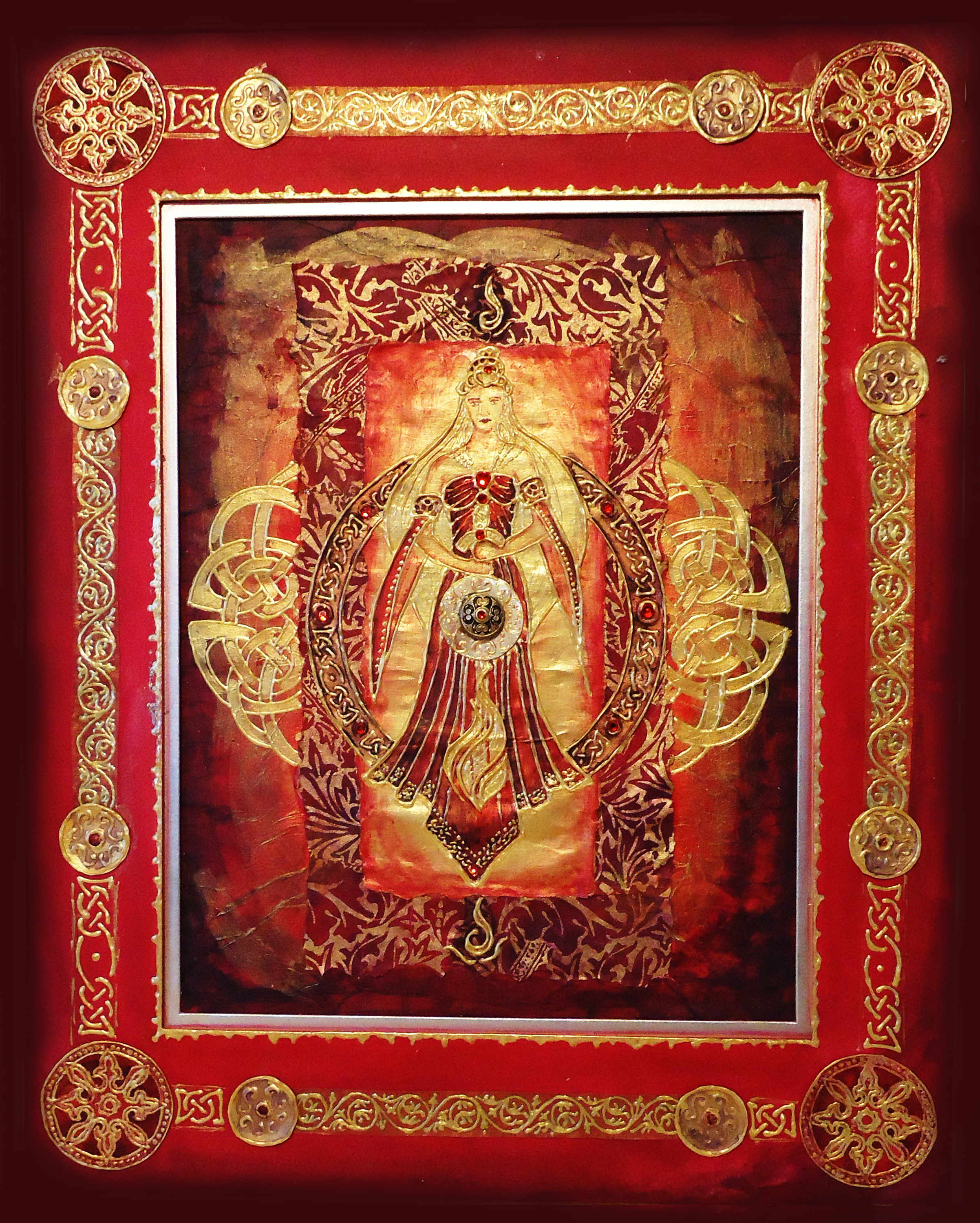Ritual Technique: Trance, Chant, and Cantillation
 I’ve been on the road for about two weeks, and I have about a dozen blog post ideas swirling in my brain, but I thought I’d ease in with a ritual technique, since this is something I use frequently when I teach and lead rituals and lots of people ask me about it. My pet name for the technique is the Trance Hammer, since I came up with it during a Brigid-themed event.
I’ve been on the road for about two weeks, and I have about a dozen blog post ideas swirling in my brain, but I thought I’d ease in with a ritual technique, since this is something I use frequently when I teach and lead rituals and lots of people ask me about it. My pet name for the technique is the Trance Hammer, since I came up with it during a Brigid-themed event.
First, a bit of background. The word “Trance” in ritual is often used to mean different things. In Reclaiming (and related) rituals, “the trance” is what people call the guided meditation part of the ritual, usually in the middle of the rite. The word meditation isn’t used because Reclaiming, Diana’s Grove, and some other traditions use what’s called dual voice trance. I’ve also heard it called open language trance. The difference is primarily this:
- A guided meditation tells you what you are thinking, seeing, and feeling
- Open language trance asks you what you are thinking, seeing, feeling, experiencing, hearing, smelling, etc.
Also:
- A guided meditation is usually one voice reciting a script
- Dual voice trance often uses one or more voices layered over one another, plus rhythmic assistance like frame drumming, singing bowls, didgeridoo, etc.
Trance and Meditation
The word trance, and meditation, are both problematic when we are talking about ritual technique because of varying connotations and meanings. That’s why I typically use the word “trance” to refer specifically to “the trance state,” which is a state of consciousness, and I use the words “trance journey” to refer to a dual voice, open language trance. Trance journey/guided meditation fulfill the same function in a ritual insofar as giving someone a guided inner experience.
A trance journey sits between a shamanic journey and a meditation; some vocal guidance is offered, but the journey asks questions to help someone create their own experience vs. telling them what everything looks like and how they should feel about that. A shamanic journey typically is just drumming with no vocal guidance.
Meditation and trance are often used interchangeably as well. People refer to “meditating” when what they mean is “achieving the trance state.” I won’t get too much into the nerdery, but getting “into trance” usually means moving your brain from Beta waves (consciousness) to Alpha waves (daydream) and then Theta waves (deeper trance state).
The word meditation, used on its own, often has the connotation of stillness meditation, za zen, empty mind. A lot of people tell me, “I can’t meditate,” because they experience the hamsterwheeling/chattering brain. Here’s a secret: So do a lot of experienced meditators! However, there are a lot of different ways to meditate, including walking, art-making, singing. Rhythmic activities work well. What works for your teacher won’t always work for you. If you are really bouncy and leg jiggly, stillness meditation isn’t going to work so well, but dancing might.
Engaging the Trance State
Let’s get back to trance journeys and the trance state. There are many different ways to get into a trance state; stillness works for some, singing for others, moving, dancing, weaving, jewelry making, staring at a candle flame…lots of roads there. But overall, there are two paths to a trance state; ergotropic and trophotropic. Which are nerdy neuroscience terms for trance through sensory deprivation, and trance through over stimulation.
In my experience, most Americans tend to respond better to an over stimulation trance. Hence, my Trance Hammer technique.
I came up with this technique when I was asked to offer something during a book launch event at Life Force Arts Center. While I wasn’t one of the authors in the Brigit: Sun of Womanhood anthology, I was local to Chicago and Joan Forest Mage asked if I’d be interested in offering something to help round out their book launch’s program of presentations. I offered to read a devotional poem to Brigid, but I also offered to get people chanting and build up a little energy.
Brigid does like the creative fire of voices singing together!
However, I faced a challenge. I design rituals to engage people in a trance state right from the beginning, deepening it with every layer. With the book launch, there was going to be almost two hours of programming that wasn’t necessarily engaging the trance state. I was at the very end and by then, a lot of people would tired of sitting, some might possibly even be a little bored, and certainly the group wouldn’t not ready to engage with singing and raising energy.
It takes a lot of work to get a group to feel comfortable participating.
Dual Voice Without a Partner
I had come up with a modified way of offering dual-voiced trance for when I travel and teach. See, the dual voice technique works best when you have at least one skilled trance partner. You learn each other’s rhythms and you get used to speaking over one another. That’s crucial for that trance technique, that two voices are speaking at the same time. Or more voices; a dual voice trance could have three or five or six or however many voices are needed. For a ritual of 500 people you’ll want at least five voices, perhaps more.
Not having a trance partner when I travel and offer workshops, or when I lead rituals at festivals, I had to adapt. I borrowed from a teaching exercise that I first learned in Reclaiming classes where four people would be asked to stand back-to-back in the center of the circle. They were each asked to choose an element, to close their eyes, and begin to rhythmically speak wisdom from that element. This is a great intro to trance technique, and it’s low-risk for people who are afraid of public speaking because 1. there are multiple voices, and 2. you can close your eyes.
In fact, I recommend this exercise on its own for shy, emerging public speakers looking to take on ritual roles.
So what I had been doing when I traveled is getting three or four volunteers to stand back to back and do this. Sometimes I had them speak the wisdom of the elements, sometimes I’d pick a few rhythmic words based upon the theme of the ritual, sometimes I’d give them a theme to work with that wasn’t elemental. I might have one person do the common Tree of Life meditation (roots down into the earth, branches up to the sky) while another one spoke of Lammas and harvest, and yet another spoke of sacrifice, of what we let go of.
While those four in the center are speaking all at once, I would lead the “plot arc” of the trance journey. I’d tell the story and lead people to the place where we did the thing, whatever that thing was in that particular ritual. It didn’t really matter if people can’t hear all the voices, or if the voices aren’t speaking the exact “right” words. What the multiple voices are doing is engaging the deep subconscious.
Trance Hammer
For that first Trance Hammer, I enlisted four volunteers. Each one would speak to one of Brigid’s triple fires, and one to her sacred well. I gave them a few starter words and had them stand in the center. I had the lights dimmed, and I invited everyone to stand up in a circular shape around the four in the center, and I got them to sing a tone/rolling OM while the four in the center were speaking.
I then sang my Brigid poem in cantillation style over all of that.
Cantillation is basically the technique you hear in Catholic mass or Eastern Orthodox where the priest is sing-songing the liturgy. Or even more potent, the priest sings a phrase and a choir sings it back to them. It’s usually singing the words of a liturgy in a rhythmic way and with just two or three notes; this doesn’t require a complex melody that you have to memorize.
In this case, singing the poem took me maybe three minutes, but that’s all it took to get everyone into a light trance state. As someone told me later, “I was trying to listen to the four in the center, and I was trying to listen to what you were singing, but I was trying to keep singing the tone, and I went to this far out place.”
When I was finished singing the poem, I allowed my voice to fall to silence, and then I brought the four in the center to silence, and then the tone fell away. In that moment, I asked everyone to take a breath, I spoke a few words to give them a chance to catch their breath, and then I asked everyone to join me in a chant to connect to the energies of Brigid, whether they thought of her as a Goddess, a saint, or just a story.
Everyone joined willingly into that chant in a way they wouldn’t have if the lights had been bright and they’d just been sitting there listening to readings for two hours. Even really engaging readings will still put a group into passive/audience mode, vs. active/participant mode, so I had to help them switch gears.
Using This in Ritual
I now use this technique all the time in ritual. Typically I do it as the Center/World Tree invocation after people call the elements. It makes a perfect transition into the trance journey portion of the ritual.
This technique works through overstimulation. What you need to pull it off are:
- Four people willing to stand in the center and speak loud enough to be heard over the toning
- One or two people to anchor the toning
- At least 10 people (15-20 is better) in the remaining group to keep the tone rolling
- One strong singer with a voice strong enough to sing over what everyone else is doing
There are, of course, ways to modify the technique depending on what your group has. Things to note that have surprised me when I’ve facilitated this: If your group has a lot of smokers, you’ll need more people to anchor the rolling tone. I did this technique in a class of about fifteen people, many who were heavy smokers, and they had a hard time keeping the tone going. Yet, you also need to ensure that the tone isn’t at such a loud volume that you can’t sing over it or hear the four voices in the center.
Also, you’ll need to work with the people in the center so that they know what an appropriate volume is; sometimes they will speak in such a soft whisper nobody can hear them, which defeats the purpose of the technique.
I realize that writing about this technique without the ability to demonstrate it might make this seem a little tricky, however, if you have a group of at least 15-20, you can try it out as a practice session and see how it goes. If you have a group of 10, you can try it with two doing the back-to-back in the center. That leaves 7 to hold the tone, and one to sing over it.
You can also do the basics of this technique with only 2 of the three parts. You can have the whole group toning (or adding harmony to the tone) while one person sings a poem/piece of liturgy/song over that, or you can have the four people in the center speaking while one person speaks (vs. sings) the trance journey.
Pro tip: This works better indoors or in a place with good acoustics. Outside with no tree cover, the sound will disappear fast. This also works well when you have dimmed lighting and a (smokeless) fire in the center to draw people’s gaze. Fire adds an additional layer to the trance and the over stimulation since it’s adding visual and kinesthetic layers.
Comments? Questions? Let me know if you’re interested in trying this out, or if you’ve tried it out and need help with fine tuning.
Filed under: Facilitation, Ritual Tagged: meditation, Pagan, Pagan community, ritual, ritual technique, trance, trance journey




